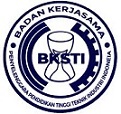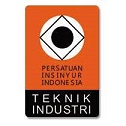Work System Design in the Wallet Production Process Using the Full Time Equivalent (FTE) and Cardiovascular Load (CVL) Method
Abstract
UKM Gudang Dompet is a company that produces wallets. The number of orders will affect employee performance because the number of targets achieved will increase the workload for employees, causing fatigue. To prevent excessive fatigue felt by workers in the production division at the Dompet Warehouse, it is necessary to measure workload. The Full Time Equivalent (FTE) method measures working time, which is based on working time, measuring the time needed to complete a particular task and then converting it into an FTE index value. The cardiovascular load (CVL) method measures physical workload based on comparing pulses. Working pulse with a maximum pulse. This research showed that worker fatigue occurred in the packing section, indicated by a CVL value of more than 30%, so FTE calculations were carried out to determine energy consumption. Based on energy consumption calculations, the results obtained are an additional rest time of 32.85 minutes in the packing section.
Keywords: workloads; full-time equivalent; CVL; work system design.
Full Text:
PDFReferences
M. A.Muzakiki, A. W.Rizqi, andE. D.Priyana, “Analisis Beban Kerja Fisiologis Pada Karyawan Bongkar Muat Bahan Bangunan Dengan Metode CVL Dan Konsumsi Kalori,” J. Tek. Ind. J. Has. Penelit. dan Karya Ilm. dalam Bid. Tek. Ind., vol. 9, no. 2, pp. 447–453, 2023.
A. R.Putri andA.Bakhtiar, “Analisis Beban Kerja Fisiologis Dan Psikologis Pada Tenaga Kerja Bongkar Muat Bahan Peledak Menggunakan Metode Cardiovaskular Load (Cvl) Dan National Aeronautics And Space Administration–Task Load Index (NASA-TLX)(Studi Kasus PT Semen Padang),” Ind. Eng. Online J., vol. 12, no. 2, 2023.
M.Dias, “Cardiovascular load assessment in the workplace: A systematic review,” International Journal of Industrial Ergonomics, vol. 96. 2023. doi: 10.1016/j.ergon.2023.103476.
N. T.Putri, “Ergonomics Evaluation of Manual Material Handling Activities in the Section of Feeding Laying Hens at Poultry Farm,” IOP Conference Series: Materials Science and Engineering, vol. 1003, no. 1. 2020. doi: 10.1088/1757-899X/1003/1/012074.
N.Panjaitan, “Calculation of Physiological Load and Energy Consumption of Warehouse Operators in Manufacturing Companies,” IOP Conference Series: Materials Science and Engineering, vol. 851, no. 1. 2020. doi: 10.1088/1757-899X/851/1/012004.
W.Kusmasari, “Measurement of Physical and Mental Workload in Onlline Ojek Drivers: A Case Study in Serang City,” Int. J. Disabil. Sport. Heal. Sci., vol. 7, no. 3, pp. 655–662, 2024, doi: 10.33438/ijdshs.1409225.
B.Bakhtiar, S.Syarifuddin, andM. P.Putri, “Pengukuran beban kerja dengan metode full time equivalent dan penentuan jumlah tenaga kerja efektif menggunakan workload analysis,” J. Ind. Eng. Oper. Manag., vol. 4, no. 1, 2021.
N.Hudaningsih, “Analisis Kebutuhan Karyawan Dengan Menggunakan Metode Full Time Equivalent (FTE) Pada Departemen Produksi PT. Borsya Cipta Communica,” J. Tambora, vol. 3, no. 2, pp. 98–106, 2019.
A.Hakiim, W.Suhendar, andD. A.Sari, “Analisis beban kerja fisik dan mental menggunakan CVL dan NASA-TLX pada divisi produksi PT X,” Barometer, vol. 3, no. 2, pp. 142–146, 2018.
S.Siswanto, E. M.Widodo, andR.Rusdjijati, “Perancangan Alat Pengupas Salak dengan Pendekatan Ergonomi Engineering,” Borobudur Eng. Rev., vol. 1, no. 1, pp. 25–38, 2021.
S. R. S.Family, “Faktor Penyebab Terjadinya Kelelahan Kerja Pada Pekerja Pt. Dungo Reksa Di Minas,” J. Pengabdi. Kesehat. Komunitas (Journal Community Heal. Serv., vol. 1, no. 1, pp. 32–37, 2021.
M.Juliana, A.Camelia, andA.Rahmiwati, “Analisis faktor risiko kelelahan kerja pada karyawan bagian produksi PT. Arwana anugrah keramik, tbk,” J. Ilmu Kesehat. Masy., vol. 9, no. 1, pp. 53–63, 2018.
Nayla Kamilia Fithri, Putri Handayani, andGisely Vionalita, “Faktor-faktor yang berhubungan dengan jumlah mikroorganisme udara dalam ruang kelas lantai 8 Universitas Esa Unggul,” digilib.esaunggul.ac.id, vol. 13, 2016, Accessed: Feb.09, 2023. [Online]. Available: https://digilib.esaunggul.ac.id/public/UEU-Article-8445-Nayla Kamilia Fithri.pdf
A. Y.Pradana andF.Pulansari, “Analisis pengukuran waktu kerja dengan stopwatch time study untuk meningkatkan target produksi di PT. XYZ,” JUMINTEN, vol. 2, no. 1, pp. 13–24, 2021.
M.Rahayu andS.Juhara, “Pengukuran Waktu Baku Perakitan Pena Dengan Menggunakan Waktu Jam Henti Saat Praktikum Analisa Perancangan Kerja,” J. Pendidik. dan Apl. Ind., vol. 7, no. 2, pp. 93–97, 2020.
E. A.Setiawan andM.Mubariz, “Penerapan Metode Full Time Equivalent (FTE) Dalam Menentukan Keseimbangan Beban Kerja Pada Distributor Pompa Air,” J. Teknol. dan Manaj. Ind. Terap., vol. 3, no. I, pp. 40–46, 2024.
D. W.Setyawan, T. S. F.Himmah, andL.Kholifah, “Optimalisasi Manajemen Beban Kerja di Assessment Center Menggunakan Metode Full Time Equivalent (FTE),” J. Teknol. dan Manaj. Ind. Terap., vol. 3, no. I, pp. 11–19, 2024.
I.Hartanto, “Sustainable Measurement of Mental and Physical Workloads of Transjakarta Bus Drivers,” IOP Conference Series: Earth and Environmental Science, vol. 1324, no. 1. 2024. doi: 10.1088/1755-1315/1324/1/012025.
R.Widiastuti, “Implementation of the cardiovascular load and rating scale mental effort to reduce the bakery worker’s workload,” AIP Conference Proceedings, vol. 2590. 2023. doi: 10.1063/5.0106674.
A.Amri, “Work system design using macroergonomic analysis and design approach to increase productivity,” AIP Conference Proceedings, vol. 2484. 2023. doi: 10.1063/5.0138960.
D.Diniaty andI.Ariska, “Penentuan jumlah tenaga kerja berdasarkan waktu standar dengan metode work sampling di stasiun repair overhoul gearbox (studi kasus: Pt. Imeco inter sarana),” J. Tek. Ind., vol. 3, no. 1, 2017.
P. E.Sekarningsih andA. F.Hadining, “Analisis Pengukuran Kerja Dalam Menentukan Waktu Baku Pada Operator Mesin Broaching Dengan Metode Pengukuran Waktu Jam Henti (Studi Kasus: PT XYZ),” J. Tek. Ind. J. Has. Penelit. dan Karya Ilm. dalam Bid. Tek. Ind., vol. 8, no. 2, pp. 175–184, 2022.
C. K.Correll, “2015 American College of Rheumatology Workforce Study and Demand Projections of Pediatric Rheumatology Workforce, 2015–2030,” Arthritis Care Res., vol. 74, no. 3, pp. 340–348, 2022, doi: 10.1002/acr.24497.
A. D.Shields, “Maintaining access to maternal fetal medicine care by telemedicine during a global pandemic,” J. Telemed. Telecare, vol. 28, no. 8, pp. 583–594, 2022, doi: 10.1177/1357633X20957468.
S. C.Kulhawy-Wibe, “Results From the 2020 Canadian Rheumatology Association’s Workforce and Wellness Survey,” J. Rheumatol., vol. 49, no. 6, pp. 635–643, 2022, doi: 10.3899/jrheum.210990.
DOI: http://dx.doi.org/10.24014/jti.v10i1.25804
Refbacks
- There are currently no refbacks.
Copyright (c) 2024 Yoni Fajar Misbaghi

This work is licensed under a Creative Commons Attribution-NonCommercial-ShareAlike 4.0 International License.
Jurnal Teknik Industri
P-ISSN 2460-898X | E-ISSN 2714-6235
Published by:
Industrial Engineering Department
Universitas Islam Negeri Sultan Syarif Kasim Riau, Indonesia
Office Address:
H.R. Soebrantas KM 15.5, Tampan, Pekanbaru, Riau, Indonesia 28293
email: jti.fst@uin-suska.ac.id
Indexed by:
JTI : Jurnal Teknik Industri under a Creative Commons Attribution-NonCommercial-ShareAlike 4.0 International License.

















